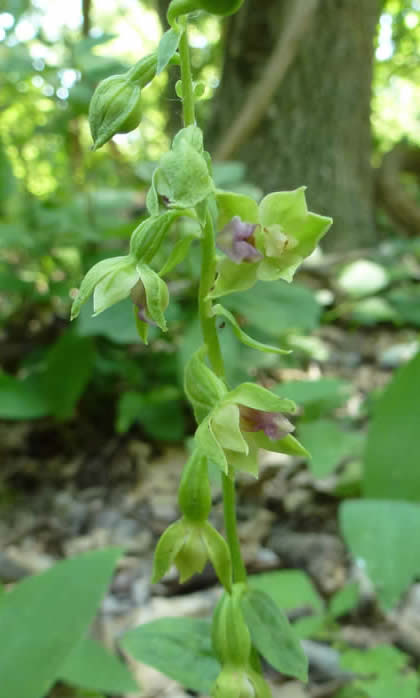Photospot: Epipactis persica
The Honeyguide group in the Danube Delta in June 2014 was taken to look for a rarely photographed species of orchid.
We took many photographs and a specimen was sent by Ibis leader Florin Palade to a botanist at Cluj-Napoca University in Romania, and parts were then forwarded to the University of Vienna for molecular analysis. The identification noted here follows that analysis, and not the name of Epipactis danubialis that we ,discussed at the time. Epipactis persica: rather closed, downward pointing flowers in a gloomy wood make photos tricky. All photos taken 9th June 2014. |
A difficult identification
Epipactis persica, according to Delforge (see right), has a distribution that is, "Huge but fragmented. from Himalayas to Anatolia". Delforge also describes Epipactis danubialis — the Danube helleborine — which on present thinking appears not to be a valid taxon.
Epipactis persica in Romania is confined to the Danube Delta. It seems valuable to show some pictures, without revealing its exact location beyond saying it was in the forest at Letea within the Danube Delta.
 |
This web page previously said that "the Danube helleborine is one of several orchids in the Epipactis leptochila (narrow-lipped helleborine) group, mostly in eastern Europe." Epipactis persica in Delforge is said to be part of the similar Epipactis phyllantes group of helleborines. Taxonomy changes here are no surprise. There are several recently described helleborine species, including Epipactis sancta, the Lindisfarne helleborine, in the UK. A more fully-flowering plant with, by chance, one flower at a sideways angle. Below: the lower part of a different plant, to show stem leaves. |

The Honeyguide visit
The previous week some Dutch botanists, travelling with Ibis, had discovered, or re-discovered, this group of Danube Delta helleborines. For us, they proved surprisingly easy to find, in the drier parts of moderately open areas in the woodland.


The orchids were mostly in bud, but a few of the pale, downward-pointing flowers were out. The triangular shape of the flower's lip of this group of species is clear.
One photographic option was to hold flowers at a sensible angle, such as here (the photo on the right is a cropped close-up of the photo on the left). Another was to take photos by lying on the damp ground against the woodland canopy and the sky — see right.
I counted 14 flowering spikes (group member Dorothy counted 30), plus the specimen taken for further botanical scrutiny. We await the verdict of the experts!
Update, May 2016: The University of Vienna was unable to say with certainty if it is Epipactis danubialis or Epipactis persica. The identification challenge continues! October 2017: after some molecular and morphologic analyses, the endemic Romanian species Epipactis danubialis is in fact Epipactis persica. In Romania, the Danube Delta is the only place where it is found.
More nature notes . . . . . . . . . . . . . . . . Honeyguide's Danube Delta holiday




